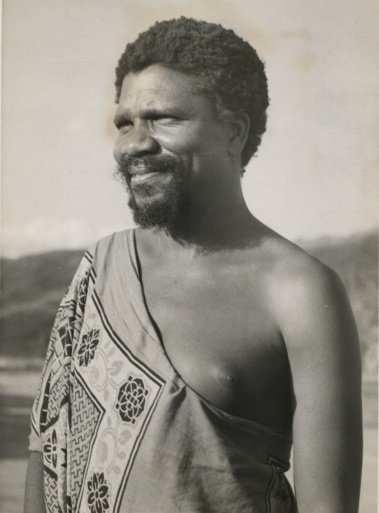by Susan Flantzer © Unofficial Royalty 2020

King Sobhuza II of Swaziland; Credit – By The National Archives UK, OGL v1.0, https://commons.wikimedia.org/w/index.php?curid=68438657
King Sobhuza II of Swaziland was the Paramount Chief and King of Swaziland, from 1899 – 1982, for 82 years and 254 days. Because Swaziland was a British protectorate from 1906 to 1968 and not a sovereign state, Sobhuza is not on the list of internationally recognized monarchs of a sovereign state. He was an internationally recognized monarch of a sovereign state for fourteen years, from when Swaziland was granted independence in 1968 until he died in 1982. However, he is number one on the list of longest reigning monarchs of dependent or constituent states.
Sobhuza (also known as Nkhotfotjeni) was born on July 22, 1899, at Zombodze Royal Residence in Zombodze, Swaziland, the son of King Ngwane V of Swaziland and Labotsibeni Mdluli, also known as Gwamile. On December 10, 1899, King Ngwane V died, aged 23, during the sacred incwala ceremony. His death, speculated to be caused by poisoning, was not announced until the ceremony was over. In Swaziland, called Eswatini since 2018, there is no heir to the throne. A special traditional council called the Liqoqo decides which of the king’s wives shall be “Great Wife” and “Indlovukazi” (She-Elephant / Queen Mother). The son of this “Great Wife” will automatically become the next king. The council then chose Ngwane’s wife Labotsibeni Mdluli and their four-month-old son Sobhuza to be Queen Mother and King. Labotsibeni Mdluli also served as regent until her son came of age.
Sobhuza was educated at the Swazi National School in Zombodze, Swaziland and the Lovedale Institution in the Eastern Cape, South Africa. In 1903, after the British victory in the Second Boer War, Swaziland became a British protectorate. Sobhuza’s title changed from King of Swaziland to Paramount Chief of the Swaziland Protectorate and would remain so until Swaziland received its independence from the United Kingdom. Sobhuza had a mostly ceremonial role during the period Swaziland was a British Protectorate, but he still had major influence as a traditional head of the Swazi nation.
Embed from Getty Images
Sobhuza, on the right, arrives in London in 1953 to attend the coronation of Queen Elizabeth II
Sobhuza was quite influential in the events leading to Swaziland’s independence. He rejected the constitution proposed by the British government, in which he would become a constitutional monarch. Instead, Sobhuza formed the Imbokodvo National Movement, a political party, which contested and won all seats in the 1967 pre-independence elections. In 1967, when Swaziland was given direct rule, Sobhuza was once again recognized as King of Swaziland. Swaziland received complete independence from the United Kingdom on September 6, 1968. Following the elections of 1973, the constitution of Swaziland was suspended by King Sobhuza II who ruled the country by decree until he died in 1982.
Despite being an absolute monarch, Sobhuza was able to blend traditional tribal customs with strategies to manage economic and social change in Swaziland. In 1978, a new constitution was adopted providing for a tribal mode of rule involving an electoral college of eighty members chosen by forty local tribal councils. Much of Swaziland’s and natural resources were originally owned by non-Swazi interests were brought under Swazi control during Sobhuza’s reign.
Embed from Getty Images
King Sobhuza in 1976
Despite converting to Christianity, King Sobhuza continued to observe traditional customs, including taking a new wife every year. This event took place at a ceremony called the Reed Dance where local young women dance in traditional costume, bare-breasted, for the king’s pleasure. As a result, King Sobhuza II married 70 wives, who gave him 210 children between 1920 and 1970. About 180 children survived infancy. At his death, he had more than 1,000 grandchildren. Sobhuza died on August 21, 1982, aged 83, in Mbabane, Swaziland.
The king’s body lay in state at the Royal Kraal, a traditional African village of huts, in Lobamba, Swaziland. The funeral was held near the Royal Kraal, in the Somhlolo Stadium. More than 20,000 people attended the funeral, including dignitaries from twenty-four countries. After the funeral, Sobhuza was entombed in the mountain cave burial grounds, the Royal Burial Ground in Nhlangano, Shiselweni, Eswatini, in a private ceremony attended only by court officials. Following Swazi custom, only three people knew the actual burial spot.
A Swazi king cannot appoint his successor, nor is there a line of succession. A traditional council called the Liqoqo decides which of the wives shall be “Great Wife” and “Indlovukati” (She-Elephant / Queen Mother) after the death of a king. The “Great Wife” must be of good character and cannot be one of the first two wives (known as ritual wives) chosen for the king by the national councilors. The son of this “Great Wife” will automatically become the next king. One of Sobhuza’s many sons, 14-year-old Mswati, was selected to be the next king reigning as King Mswati III. From 1982-1986, two wives of the late King Sobhuza II, Queen Dzeliwe Shongwe, and Mswati’s mother, Queen Ntfombi Tfwala, served as regents.
This article is the intellectual property of Unofficial Royalty and is NOT TO BE COPIED, EDITED, OR POSTED IN ANY FORM ON ANOTHER WEBSITE under any circumstances. It is permissible to use a link that directs to Unofficial Royalty.
Works Cited
- En.wikipedia.org. 2020. Eswatini. [online] Available at: <https://en.wikipedia.org/wiki/Eswatini> [Accessed 17 August 2020].
- En.wikipedia.org. 2020. Sobhuza II. [online] Available at: <https://en.wikipedia.org/wiki/Sobhuza_II> [Accessed 17 August 2020].
- Flantzer, Susan, 2014. King Mswati III Of Eswatini (Formerly Swaziland). [online] Unofficial Royalty. Available at: <https://www.unofficialroyalty.com/king-mwsati-iii-of-swaziland/> [Accessed 17 August 2020].
- profile, V., 2015. The Funeral Of King Sobhuza. [online] Rosehiptrue.blogspot.com. Available at: <http://rosehiptrue.blogspot.com/2015/02/the-funeral-of-king-sobhuza.html> [Accessed 17 August 2020].
- UPI. 1982. King Sobhuza II, The ‘Lion Of Swaziland,’ Was Entombed…. [online] Available at: <https://www.upi.com/Archives/1982/08/23/King-Sobhuza-II-the-Lion-of-Swaziland-was-entombed/7971398923200/> [Accessed 17 August 2020].
